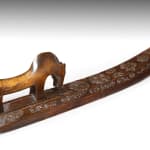Early 18th Century Danish Carved Birchwood Mangle Board
7 ¼ x 28 x 4 in
Further images
Tapering in width and curved. With a dove-tailed handle carved in the shape of a horse and with carved foliate decoration along the length of the board. Inscribed with the initials ‘CHO’ and dated ‘Ano 1700’.
In his book ‘Treen & Other Wooden Bygones’, Edward H. Pinto includes a section on mangling boards, in which he describes them as a domestic implement, formerly used in many parts of Europe but more particularly in Scandinavia and Friesland, which would have been used to smooth out linen or clothing as it passed through a mangle, before being discarded for the flat iron. A mangling board was used in conjunction with a roller (Edward H. Pinto, ‘Treen & Other Wooden Bygones’ (Bell & Hyman, London, 1979), p.153).
In ‘An Encyclopedia of the History of Technology’ Ian McNeil states: ‘During the sixteenth century the mangling board and roller came into general use. The idea spread from Holland, Denmark and northern Germany.... The material was wrapped round the roller... which was placed on a flat table. The mangling board [was] then passed backwards and forwards over the roller until the fabric was smoothed... The idea was exported by Dutch colonists, particularly to North America and South Africa’ (Ian McNeil, ‘An Encyclopedia of the History of Technology’ (Routledge, 1990).) This action was a hand version of the wheel and chain operated box mangle. While the board could be beautifully decorated on one side – sometimes with carved initials and dates as in this example – the roller had to be smooth and plain for effective ‘ironing’.
Pinto explains that mangling boards from Scandinavia and Friesland were handsomely caved, serving a secondary purpose as ornaments in the home and as a reminder of man’s prowess in carving. Making an attractive carved mangling board, such as this one, was a part of the winter’s ‘husflid’, traditional carving which is carried out during the long winter months when it is not possible to work outside. Such mangling boards were not only used as ornaments within the home but were also sometimes hung outside the entrance door to the house to publicise that the owner took in laundry (Pinto, ‘Treen & Other Wooden Bygones’, p.153).
By tradition, mangling boards became a popular courtship gift, hand-carved by men to be given to their brides at their engagement. They often bore the year of manufacture and the initials of the recipient – as in this example. The primary objects created and offered by male suitors were tools and implements related to domestic tasks – spinning, weaving, cleaning, smoothing and other working of cloths – as young women invariably spent their days working together with textiles and their suitors’ gifts enabled could be shown off to their colleagues and friends. It was a sign of honour to have a beautifully carved mangle board hanging on your wall (see Robert Young’s article ‘Folk Art Love Tokens’ in ‘Antique Collecting’, September 2011, pp.20-24).
Much of northern Europe used to be covered in forests of birch and pine - woods which were good for general carpentry, but not suitable for fine and detailed carving. Traditional decoration therefore tended to be large and bold with geometric and floral chip carved patterns as in this example. Pinto explains that Scandinavian mangling boards were thicker and heavier than boards from Friesland (northern Netherlands) because wood – birch and pine – was more abundant in Scandinavia, whereas boards from Friesland were made of oak and were much lighter (Pinto, ‘Treen & Other Wooden Bygones’, p.153). Animal-shaped handles, exemplified by the horse in this example, were often favoured in Denmark Norway, and Sweden (ibid, plate 153).
Kai Uldall illustrates a number of different mangle boards decorated with carved horses of a similar design in ‘Gammel Dansk Folkekunst’ (Thaning & Appels Forlag, 1966), p.88, figure 70.






